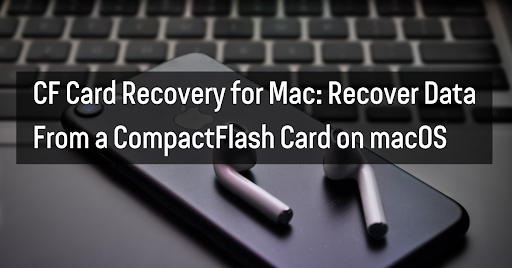CompactFlash (CF) cards are a popular memory card used in digital cameras, camcorders, and other devices. They are known for their durability and high storage capacity. However, like any storage device, CF cards can become corrupted or damaged, losing important data.
If you find yourself in this situation, don’t panic. There are several ways to recover data from a CF card on macOS. In this article, we will discuss the most effective methods for CF card recovery on a Mac.
Method 1: Use a CF Card Reader
The first step in recovering data from a CF card is to use a CF card reader. This device connects to your Mac via USB and allows you to access the contents of the CF card. Once you connect the CF card reader to your Mac, you can use the built-in Disk Utility to scan the CF card for errors. If any errors are found, you can then attempt to repair them.
Method 2: Use Data Recovery Software
If the built-in Disk Utility cannot repair the CF card, or if the card is severely damaged, you may need to use data recovery software. Several data recovery software options are available for Mac, such as Disk Drill, EaseUS Data Recovery Wizard, and Stellar Data Recovery. These programs can scan the CF card for any recoverable data and allow you to save the recovered files to your Mac.
Method 3: Send to a Professional Data Recovery Service
If the above methods are unsuccessful, sending the CF card to a professional data recovery service may be necessary. These services specialize in recovering data from damaged or corrupted storage devices, and they have the specialized equipment and expertise to recover data from even the most severely damaged cards.
Additional information:
- When recovering data from a damaged CF card, it is important to be cautious, as any mishandling could cause further damage.
- If you are unsure of how to proceed, it is always best to consult with a professional data recovery service.
Preventing
To prevent data loss on CF cards, here are some tips to follow:
- Properly Eject the CF Card: Always make sure to properly eject the CF card from your Mac before removing it. This ensures that any changes made to the card are saved and prevents the risk of corruption.
- Regularly Backup Your Data: Regularly backup your CF card data to an external hard drive or cloud storage. If the CF card becomes corrupted or damaged, you will have a copy of your data to restore.
- Avoid Power Surge: Avoid using the CF card or devices that use the card during a power surge. Power surges can cause damage to the card, resulting in data loss.
- Don’t Overwrite the CF Card: Avoid overwriting the CF card, as it can cause the previous data to become inaccessible. Instead, format the card before reusing it.
Formatting a memory card means that a new file system will overwrite it. This means that all data on the card will be lost.
However, if the data on the memory card has been corrupted, formatting can help you recover it. Formatting allows only the damaged areas of the card to be overwritten. Undamaged data can be recovered using data recovery software.
- Keep the CF Card Safe: Keep the CF card in a safe and secure place, away from extreme temperatures, moisture, and physical damage.
- Check for Errors: Check for errors on the CF card regularly by using a CF card reader and the built-in Disk Utility on your Mac. If any errors are found, you can then attempt to repair them.
Following these tips can significantly reduce the risk of data loss on your CF card. Remember, it’s always better to be proactive in protecting your data rather than trying to recover it after it’s lost.
In conclusion
Recovering a CF card on a Mac is possible using various methods. If you are lucky and patient, you can recover the lost data and return to regular operation with your CF card.

